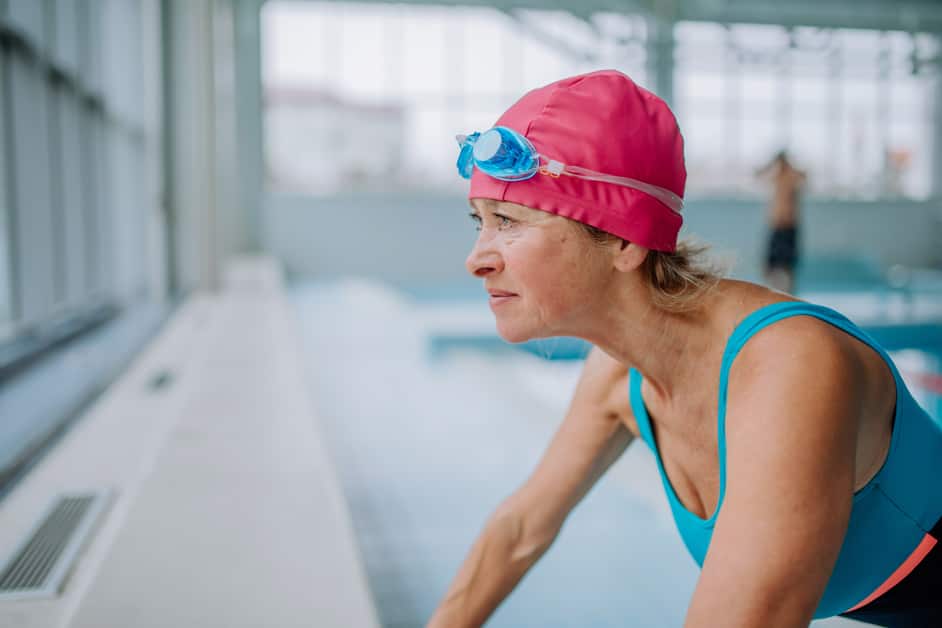Introduction
Knee pain can be hard to deal with. Low-impact workouts are the key to take stress off of your knees. Even small tweaks to your routine can help your mobility and reduce discomfort.
Sadly, many folks with knee pain avoid physical activity. But good news – low-impact exercises can reduce inflammation and improve flexibility without worsening the joint. Doing these activities regularly will keep joints healthy and help you stay active without more injury or pain.
This guide looks at low-impact exercises to reduce knee pain and improve mobility. We’ll discuss why each exercise helps, with tips to do them safely without too much stress on sensitive areas.
Low-Impact Workouts for Knee Pain
Minimizing the tension on your joints can be a great way to manage knee pain. Low-impact exercises are ideal for this purpose. You can add these exercises to your daily routine and notice a decrease in discomfort. Let us explore the best ones:
Swimming
Swimming is a great way to exercise and reduce stress on joints. The water supports your body, allowing you to move with more ease and prevents strain on your knees. It also helps reduce joint swelling due to overuse or conditions like arthritis. Swimming uses all major muscle groups, making it a full-body workout. This increases flexibility and strengthens power, range of motion and endurance.
Benefits of swimming for knee pain include:
- Reduced stress on joints: The resistance of the water allows for smooth movement without causing further knee strain.
- Increased flexibility and range of motion around the joint: The buoyancy of the water provides a great nonimpact stretching environment, keeping joints loose.
- Added strength: Water resistance creates an effective workout to strengthen muscles, which can provide additional knee support during activities such as running.
- Improved coordination and stability: Working against the water’s current supports your body while improving balance, coordination and postural control needed for workouts on land and walking.
Walking
Walking is great for those with painful knees! It’s a low-impact activity that is easy to tolerate. It strengthens the muscles that support the knee joint, helping them absorb shock and reduce pain. Plus, it helps control weight, taking stress off the joints.
To get the most out of your walking routine, start slowly and gradually increase the pace. Add ankle weights, walking sticks, or poles to challenge yourself. If walking on hard surfaces like concrete is too much, try exploring local trails or flat grassy paths.
Cycling
Cycling is great for the body! It’s low-impact and helps reduce knee pain. It’s gentle on the joints, like running, but with less wear and tear. The large lower body muscles—quadriceps, hamstrings, glutes, and calves—all help support your joints when you move.
When cycling to relieve knee pain, build up slowly. Start with short (10-15 min), moderate intensity sessions on flat terrain. As you get stronger, increase speed and duration. A comfortable saddle and correct riding technique will prevent extra joint stress, which can lead to more knee pain.
Pilates
Pilates is a low-impact form of exercise. It focuses on improving core strength, posture, flexibility and balance. Working on these can be beneficial for those with knee pain.
Exercises which focus on strengthening the abdominal muscles and controlling the knees are key. Range of motion activities to increase mobility in areas such as the hips and thighs can help relieve knee pain.
Done correctly, these types of Pilates can be successful without any further damage or pain. They are ideal for those suffering from chronic aches and pains.
Here are some exercises which can help:
- Lateral stretches help strengthen the inner joint capsule and quads.
- Leg swings target gluteus medius for better hip stabilization.
- Standing extension exercises increase hamstring strength.
- Front and side planks work on powerful quadriceps and external obliques.
- Clamshells work towards stability in quads and activating external obliques.
- Straight-leg lifts build up strong hamstrings.
Yoga
Yoga is great for your knees! It can help with strength and flexibility. Warrior, Triangle and Half Moon poses are special for knee muscles. Squats, lunges and stretches help reduce knee pain and make mobility better.
Yoga is also great for your mind. You can focus better and relax. Doing yoga regularly can help you feel calmer and healthier. Some studios offer classes for people with knee pain or arthritis. Ask if one is near you.
Benefits of Low-Impact Workouts
Low-impact workouts are a great choice instead of high-impact exercises. They can help build strength and improve your fitness, without risking an injury or pain. Plus, these workouts are especially helpful for those with knee or joint pain.
Let’s explore the advantages of low-impact workouts!
Improved Mobility
Low-impact workouts focus on improving mobility and flexibility. They also help strengthen muscles. Participants target big muscle groups through moves that don’t cause much impact. This boosts their range of motion and balance. It’s great for people who have injuries, as it’s gentle on the body.
Low-impact exercises aid post-workout recovery by increasing blood flow. This leads to faster recovery times. Improved mobility and flexibility can improve performance in various activities. Plus, it reduces the risk of injury and chronic pain.
Reduced Pain
Low-impact exercise has lots of advantages, perfect for people with chronic joint ache. These workouts can lessen the agony from osteoarthritis, fibromyalgia, and other persistent conditions. By reducing the weight on sore joints and muscles, low-impact workouts let individuals exercise with ease while still gaining all the advantages of exercise.
Low-impact activities also burn a large amount of calories and boost overall endurance, strength, and energy. Even if you are an experienced fitness enthusiast who has been stopped by an injury or joint pain, low-impact exercises can still aid you to reach your goals. Not only will you be able to conquer any blocks between you and your fitness routine but you’ll also profit from the following:
- Lower risk of injury – Low-impact exercise puts less stress on your bones and muscles than higher impact exercise such as running or jumping which can raise the danger of injury.
- Decrease in joint pain – Low-impact activities carefully target certain muscles without putting too much strain on vulnerable joints which assists in minimizing pain in the affected area.
- Improved health – Low-impact exercises have been demonstrated to reinforce the cardiovascular system, burn fat and cholesterol levels reducing your risk of heart disease and stroke.
- Improved posture – Many low-impact activities improve general balance which helps you maintain better posture throughout everyday life as well as while executing other workouts such as yoga or Pilates classes.
Low-impact exercises offer some great benefits without needing to overlook getting a good workout in! Now is the ideal time to start including low-impact exercises into your routine so that you can stay healthy while avoiding unnecessary discomfort caused by high-impact exercises.
Improved Strength
Improving muscle strength is why many exercise. Low-impact workouts are a great way to do this without straining your joints. Pilates is one of these exercises and can target specific muscles while avoiding pain. Pilates also helps increase flexibility and body strength.
Yoga and tai chi are other low-impact activities that involve using multiple muscles together. They offer improvements in strength and concentration, as well as relaxation.
Low-impact activities don’t need expensive equipment or a gym membership.
- Walking
- Jogging
- Swimming
- Riding an exercise bike
- Aqua aerobics
are all good beginner exercises. These keep you active without stressing your body.
Improved Flexibility
Low-impact exercise is the ideal way to boost flexibility. It works the body without stressing muscles and joints. This helps lower the risk of injuries, making it great for those with limited mobility, like people with arthritis or chronic back pain.
It’s also helpful for those getting back into physical activity after an injury or operation.
Stretching exercises like yoga, tai chi, Pilates and barre classes are great for improving flexibility. Going for a swim, walking or light weight lifting with low weights and high reps also helps. Taking some time out of the day to do gentle stretching can increase flexibility and provide a calming effect.
Tips for Safe Low-Impact Workouts
Low-impact workouts – super for managing knee pain! They are kind to your body and joints plus help you reach your fitness goals without stressing. Many low-impact options exist. Here are some tips to keep in mind when training at home or the gym.
Let’s look at these tips for safe, effective low-impact workouts:
Wear Proper Shoes
Choosing the right shoes is key when you’re working out to reduce knee pain. Shoes without enough support or cushioning can cause injury to your knees and other joints.
If you have knee pain, look for shoes made for running. These have cushioning, arch support, and shock absorption in the heel. Avoid high heels, heavy boots, and flimsy sandals during low-impact exercise. You need footgear that exposes your feet to the ground.
Replace your walking or running shoes after 350-500 miles of wear. The cushioning breaks down and needs to be renewed to protect your joints.
Warm Up and Cool Down
Before you start any exercise, warm up your muscles! This helps prevent injury. March in place or do arm circles to get the heart rate up. Stretch to increase flexibility.
After a workout session, cool down for 5-10 minutes. Especially if you did aerobic activities like running or walking for more than 15 minutes. Walk or jog slowly for a few minutes. This lowers heart rate and gets rid of toxins from the muscles.
Be sure to warm up and cool down every time you exercise. This keeps you healthy and safe!
Listen to Your Body
It’s important to use the right technique and form when doing low-impact exercises. Ask a fitness pro or physical therapist if you’re unsure how to do an exercise or stretch safely.
Pay attention to your body and listen to signals that may mean you’re getting injured. Signs like swelling, tenderness, soreness, aching, and stiffness mean your body needs a break. Don’t exercise until it’s fully recovered.
Start with a realistic approach when beginning any new exercise routine. Begin slowly with lighter weights for resistance exercises. Gradually increase reps and intensity for cardio activities. Warm up with stretches before and after each session, and take short breaks during workouts.
Low-impact exercises should be done gradually. Don’t move too fast. End workouts with stretches to help promote flexibility and better recovery.
Stay Hydrated
Staying hydrated is key for your body’s health and performance while exercising. It also helps reduce joint pain by keeping the joint tissues lubricated and making movement easier.
Always sip water, especially if you are doing low-impact exercise like walking or swimming. Carry your bottle and have regular drinks during your workout. Aim for 8 ounces of water for each 15 minutes of activity, depending on your workout intensity.
It’s important to not over drink. Too much fluid can give stomach cramps or nausea, making it tough to finish your workout. Monitor how you feel throughout and adjust your intake. To replace electrolytes lost through sweat, add a sports drink or electrolyte supplement to your routine if you are doing long or intense workouts.
Conclusion
If you want exercise in your life and to guard your knees, try some of the low-impact exercises. Exercise can help in many ways – from lessening symptoms to preventing joint damage. These workouts don’t need the same range of motion or speed as high-impact activities. But, they do require a similar level of cardio endurance.
No matter your age or physical abilities, there’s a low-impact program for you. Concentrate on form not speed and increase gradually to get the most benefit. And, most importantly, to protect your knees!
Frequently Asked Questions
Q: What kinds of low-impact workouts can I do to help alleviate knee pain?
A: Low-impact exercises such as walking, swimming, cycling, and yoga are all great ways to help alleviate knee pain. Additionally, stretching exercises such as simple leg lifts and hamstring stretches can help to reduce knee pain.
Q: Are there any other tips or tricks to help with knee pain?
A: Yes! In addition to low-impact exercises, you can also try icing your knee after workouts and avoiding activities that put a lot of stress on your knees. Additionally, you should always make sure to wear the right kind of shoes and use the right form when exercising.
Q: How often should I do low-impact workouts to help with my knee pain?
A: Depending on the severity of your knee pain, you should aim to do low-impact exercises at least three times a week. However, it’s important to listen to your body and take it slow. If you experience any pain, stop immediately and consult your doctor.





